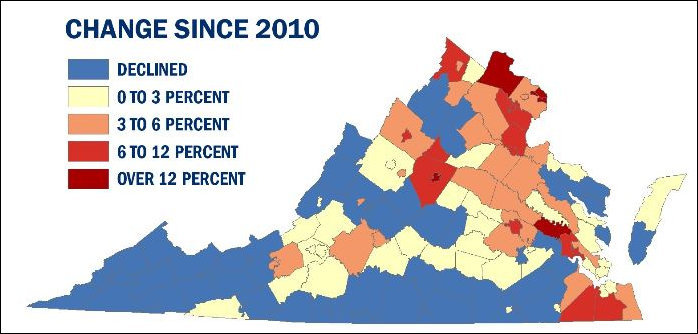
Dozens of Virginia localities have lost population since 2010. Does it make sense to impose unfunded mandates on jurisdictions with shrinking tax base and school enrollment?
There seems to be no end to the ideas that Do Gooders have to improve conditions in Virginia’s schools. And there’s always someone in the General Assembly willing to submit a bill to force Virginia school districts to adopt those feel-good ideas without providing any money to pay for them.
This year, the Do Gooders have backed unfunded mandates that would require every school in Virginia to hire a nurse and every school district in the state to hire a dyslexia adviser. I have no quarrel with the aspiration of employing more nurses and dyslexia advisers in our schools. But I do take issue with enacting bills that would impose those priorities over those of local school boards, many of which are grappling with shrinking budgets and all of which have a keener insight into local needs than anyone in Richmond.
Fortunately, the House Appropriations Subcommittee on Elementary and Secondary Education killed HB 1757, the nurse bill, recognizing that unfunded mandates create fiscal hardship for local school divisions, reports the Richmond Times-Dispatch.
The Virginia Association of School Nurses said the state has one school nurse per 830 students. The bill would have mandated a ratio of one nurse per 550 students. Children need the service of trained professionals to deal with a host of medical conditions, the nurses argued. Ailments range from Type 1 diabetes to seizures, asthma and severe allergies. Some school districts put a nurse in every school. But some have other priorities. Small districts would be especially hard-pressed to meet the standard.
Another bill, HB 2395, would require every school district to staff a dyslexia specialist. The Dyslexia Research Institute contends that 10% to 15% of the U.S. population has the learning disability, but only one in twenty dyslexics are recognized and receive assistance. The syndrome interferes with children’s ability to learn how to read.
In this instance, reports the Times-Dispatch, the House Appropriations subcommittee approved the bill, which follows a law enacted last year that required new teachers to receive training in identifying and dealing with dyslexia.
Larger school districts already maintain dyslexia specialists. Here’s my question: What’s different between an unfunded mandate for hiring dyslexia specialists and an unfunded mandate for hiring school nurses? Perhaps the price tag is smaller — a single dyslexia specialist costs less than multiple school nurses. But the underlying principle is the same — the General Assembly is imposing its priorities upon local school boards.
While all this is going on, lawmakers are grappling with the financial problems experienced by shrinking school divisions. As coincidence would have it, the Demographics Research Group at the University of Virginia, has just published its latest population data. As can be seen in the map above, dozens of localities have lost population since 2010. Presumably that population decline is matched by a decline in school population.
According to a third article in today’s Times-Dispatch, 39 localities have lost either 1,000 students or 20% of their enrollment between 2006 and 2016. Lower enrollments mean less state support for schools. The House Appropriations Committee is considering a bill that would scrape up $8.6 million to provide relief for those jurisdictions on the grounds that they are too small to offset the loss of state revenue by consolidating services and facilities.
In what world does it make sense to impose a new unfunded mandate — in this case, the dyslexia expert — upon these localities?


